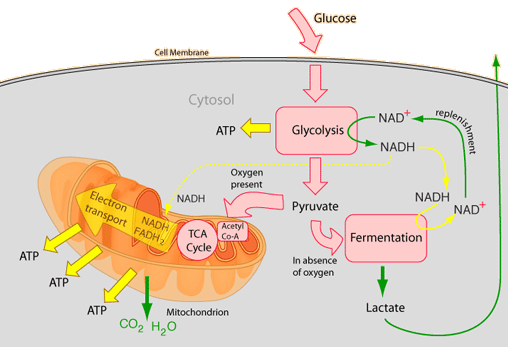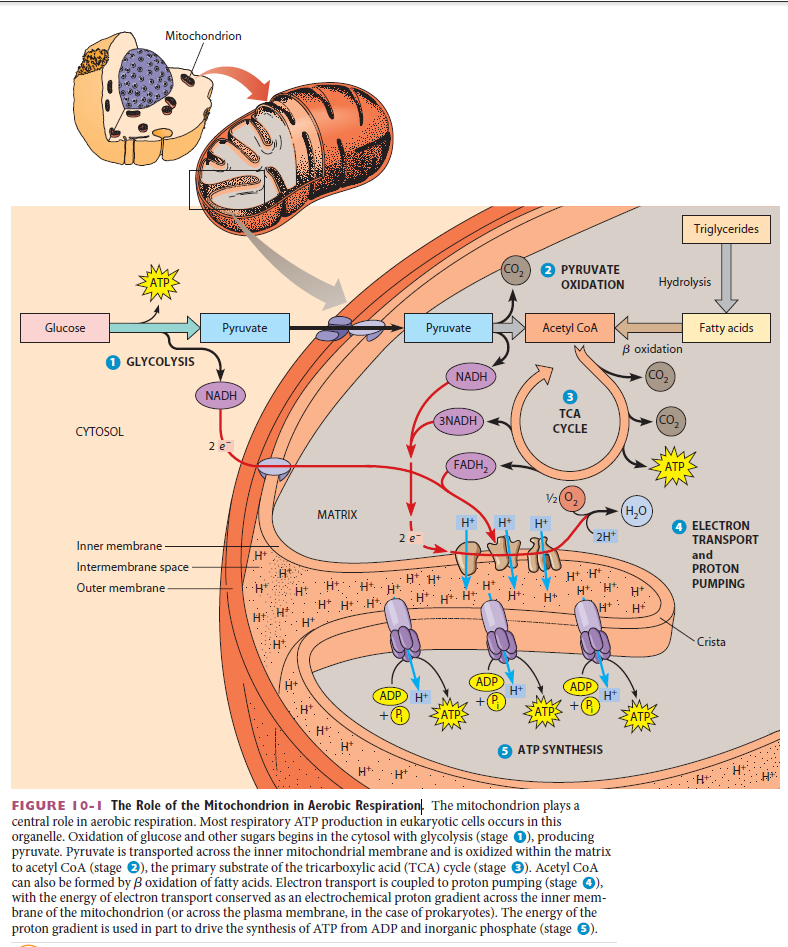The Role of the Mitochondrion in Aerobic Respiration 1
https://reasonandscience.catsboard.com/t2154-the-role-of-the-mitochondrion-in-aerobic-respiration
The term cellular respiration refers to the biochemical pathway by which cells release energy from the chemical bonds of food molecules and provide that energy for the essential processes of life. All living cells must carry out cellular respiration. It can be aerobic respiration in the presence of oxygen or anaerobic respiration. Prokaryotic cells carry out cellular respiration within the cytoplasm or on the inner surfaces of the cells. More emphasis here will be placed oneukaryotic cells where the mitochondria are the site of most of the reactions. The energy currency of these cells is ATP, and one way to view the outcome of cellular respiration is as a production process for ATP.

The graphic below can serve as a reminder of some of the processes involved in cellular respiration.
 T
T
Cellular respiration produces CO2 as a metabolic waste. This CO2 binds with water to form carbonic acid, helping to maintain the blood's pH. Since too much CO2 would lower the blood's pH too much, the removal of the excess CO2 must be accomplished on an ongoing basis.

Respiration Includes Glycolysis, Pyruvate Oxidation, the TCA Cycle, Electron Transport, and ATP Synthesis We will consider aerobic respiration in five stages, as shown in the Figure above. The first three stages involve substrate oxidation and the simultaneous reduction of coenzymes, and the second two involve coenzyme reoxidation and the generation of ATP. In cells, of course, all five stages occur continuously and simultaneously. Stage is the glycolytic pathway that we encountered in Chapter 9. The steps of glycolysis are the same under aerobic and anaerobic conditions and result in the oxidation of glucose to pyruvate. However, in the presence of oxygen, the fate of the pyruvate is different . Instead of serving as an electron acceptor, as occurs in anaerobic fermentation, pyruvate is further oxidized. In stage , pyruvate is oxidized to generate acetyl coenzyme A (acetyl CoA), which enters the tricarboxylic acid (TCA) cycle (stage ). The TCA cycle completely oxidizes acetyl CoA to and conserves most of the energy as highenergy reduced coenzyme molecules. Stage involves electron transport, or the transfer of electrons from reduced coenzymes to oxygen, coupled to the active transport (pumping) of protons across a membrane. The transfer of electrons from coenzymes to oxygen is exergonic and provides the energy that drives the pumping of protons across the membrane containing the carriers. This generates an electrochemical proton gradient across the membrane. In stage , the energy of this proton gradient is used to drive ATP synthesis in a process known as oxidative phosphorylation. Our goal in this chapter is to understand the processes following glycolysis—the complete oxidation of pyruvate in the TCA cycle, electron transport from pyruvate via coenzymes to oxygen, and the formation of a proton gradient that drives ATP synthesis. We will begin our discussion of aerobic energy metabolism with a close look at the mitochondrion because of its prominent role in eukaryotic energy metabolism.
https://reasonandscience.catsboard.com/t2154-the-role-of-the-mitochondrion-in-aerobic-respiration
The term cellular respiration refers to the biochemical pathway by which cells release energy from the chemical bonds of food molecules and provide that energy for the essential processes of life. All living cells must carry out cellular respiration. It can be aerobic respiration in the presence of oxygen or anaerobic respiration. Prokaryotic cells carry out cellular respiration within the cytoplasm or on the inner surfaces of the cells. More emphasis here will be placed oneukaryotic cells where the mitochondria are the site of most of the reactions. The energy currency of these cells is ATP, and one way to view the outcome of cellular respiration is as a production process for ATP.

The graphic below can serve as a reminder of some of the processes involved in cellular respiration.
 T
These are active graphics: click anywhere.
Cellular respiration produces CO2 as a metabolic waste. This CO2 binds with water to form carbonic acid, helping to maintain the blood's pH. Since too much CO2 would lower the blood's pH too much, the removal of the excess CO2 must be accomplished on an ongoing basis.

Respiration Includes Glycolysis, Pyruvate Oxidation, the TCA Cycle, Electron Transport, and ATP Synthesis We will consider aerobic respiration in five stages, as shown in the Figure above. The first three stages involve substrate oxidation and the simultaneous reduction of coenzymes, and the second two involve coenzyme reoxidation and the generation of ATP. In cells, of course, all five stages occur continuously and simultaneously. Stage is the glycolytic pathway that we encountered in Chapter 9. The steps of glycolysis are the same under aerobic and anaerobic conditions and result in the oxidation of glucose to pyruvate. However, in the presence of oxygen, the fate of the pyruvate is different . Instead of serving as an electron acceptor, as occurs in anaerobic fermentation, pyruvate is further oxidized. In stage , pyruvate is oxidized to generate acetyl coenzyme A (acetyl CoA), which enters the tricarboxylic acid (TCA) cycle (stage ). The TCA cycle completely oxidizes acetyl CoA to and conserves most of the energy as highenergy reduced coenzyme molecules. Stage involves electron transport, or the transfer of electrons from reduced coenzymes to oxygen, coupled to the active transport (pumping) of protons across a membrane. The transfer of electrons from coenzymes to oxygen is exergonic and provides the energy that drives the pumping of protons across the membrane containing the carriers. This generates an electrochemical proton gradient across the membrane. In stage , the energy of this proton gradient is used to drive ATP synthesis in a process known as oxidative phosphorylation. Our goal in this chapter is to understand the processes following glycolysis—the complete oxidation of pyruvate in the TCA cycle, electron transport from pyruvate via coenzymes to oxygen, and the formation of a proton gradient that drives ATP synthesis. We will begin our discussion of aerobic energy metabolism with a close look at the mitochondrion because of its prominent role in eukaryotic energy metabolism.


